Do you realize how many foreign substances there are in a delicious meal you eat, the air you breathe, and the people you shake hands with? Sometimes, even the water you drink contains germs that can make you ill and viruses that can go into action at any time. Yet you will not even be aware of the presence of these often poisonous substances that enter your body, dozens of times a day.
The reason for this is the existence of an army specially charged with identifying and eliminating toxins. This powerful defense force—created by God as a blessing for human beings, and the like of which exists nowhere else on Earth—constantly patrols the blood vessels.
White blood cells are also known as leukocytes. Under normal conditions there are between 6,000 and 10,000 leukocytes in 1 cubic millimeter of blood. There is an average of 500 erythrocytes for every leukocyte in the bloodstream. If all the leukocytes in the bloodstream were to be gathered together, they would just about fill a coffee cup.37 When an infection begins, however, the number of leukocytes in that cubic millimeter of blood may rise to 30,000.38
 |
Do you not know that Good is He to Whom the kingdom of,heavens and the Earth belongs and that,besides God you have no protector and no helper? Surat al-Baqara:107 |
These cells are soldier cells, identifying and waging war on all kinds of foreign bodies that enter the body. Some fight germs directly, while others stimulate the immune system by recognizing foreign molecules and microbes.
White blood cells are produced in the bone marrow at a production rate of 1.2 million a second. That amount adds up to fully half a ton of white blood cells during a person's lifetime.39 The bone marrow serves just like a shelter or warehouse for the white blood cells.
There is also a quantity of leukocytes standing ready in the blood. For them the circulatory system is a matchless means of transport through which they can reach every corner of the body. Microbes entering through the bloodstream are destroyed all along its course, and those that enter the tissues are eliminated wherever the white blood cells can reach.
It takes around 10 seconds for a white blood cell to leave the heart, reach the head and return; and roughly one minute to reach the big toe, the furthest point in the body, and return to the heart. A single leukocyte will travel through the body more than 1,000 times a day.40 Despite having a nucleus, a leukocyte—which is a colorless and not strictly "white" cell—loses its ability to divide after entering the bloodstream. Its objective now is not to divide and reproduce, but to wage war.
After entering the bloodstream, the leukocytes' lifespan is from 3 to 4 hours in the blood, and 3 to 4 days in tissues.41 These warriors, created by God to protect the body, eliminate the relevant danger in that space of time.
 |
If there had been any gods besides God in heaven or Earth,they would both ruined.Glory be to God, Lord of the Throne beyond what they describe!(Surat al-Anbiya: 22) |
In cases of severe infection, the leukocytes' lifespan falls to just an hour or two. That is because these cells head towards those regions of the body that are under attack, discharge their defensive duties there, and shortly afterwards die of exhaustion or of poisoning by the invader once their mission has been accomplished. At the same time, however, production continues in the bone marrow in order to keep fighting and eliminate the infection.
Even if there is no infection in the body, the leukocytes are not redundant. Even if not defending the body from enemies, they still have important tasks to perform. They go on patrol, visiting every one of the 100 trillion cells in the body several times a day—during which patrols they identify and eliminate sick or aged cells. Even aged white blood cells that are unable to do their jobs are eliminated by still other leukocytes.
In general terms, white blood cells are classified under five groups, depending on their size and whether or not they possess a nucleus. These include lymphocytes (T and B), monocytes, neutrophils, eosinophils, and basophils. The division of labor among these defensive cells is precise and literally flawless.
A great many people are unaware of the risks posed by blood clotting, a requirement of the perfection of the whole system. Yet as you shall shortly see in some detail, the clotting process is not only a matchless and life-saving system, but also one that can represent a grave danger in the event that it fails to function properly—for example, if clotting takes place inside the body.
Blood begins to clot the moment it comes to the skin surface and makes contact with the air—a perfect system that saves our lives. However, if blood should clot inside the veins in the same way as it does on the surface, that may soon result in death. Even the smallest blood clot is large enough to block one of the veins leading to the heart—a danger that is eliminated by the basophils.
Basophils deposit in the blood a compound called heparin—a special substance that prevents blood clotting inside the veins. This precautionary measure eliminates any potential threat before it ever arises. This is an important condition that we encounter constantly in examining the human body: Precautions are taken before a threat ever raises its head.
The White Blood Cells That Protect 100 Trillion Cells | |||
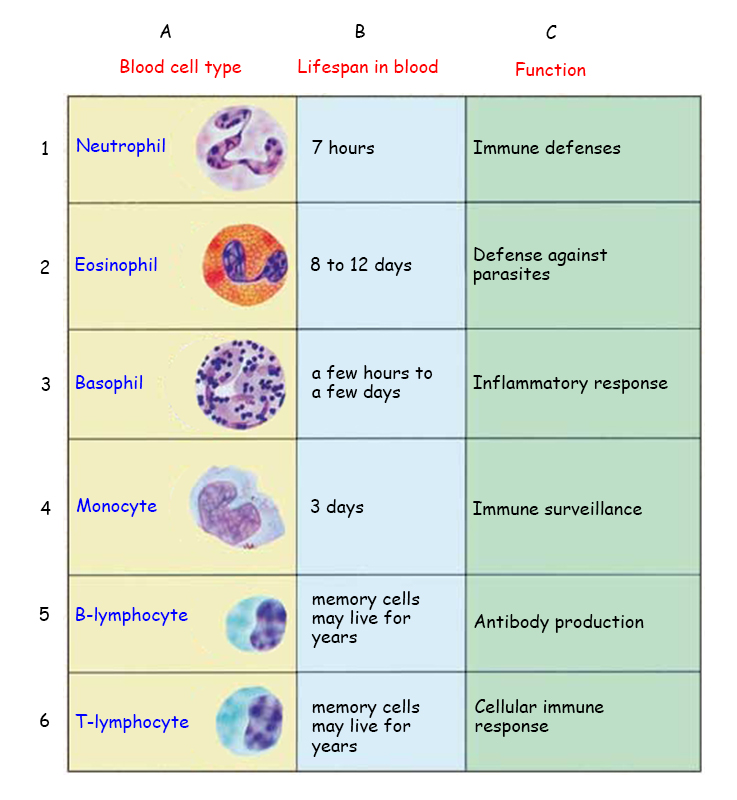 | |||
| A. Blood cell type | B. Lifespan in blood | C. Function | |
1. Neutrophil 2. Eosinophil 3. Basophil 4. Monocyte 5. B-lymphocyt 6. T-lymphocyte | 1B. 7 hours 2B. 8 to 12 days 3B. a few hours to a few days 4B. 3 days 5B. memory cells may live for years 6B. memory cells may live for years | 1C. Immune defenses 2C. Defense against parasites 3C. Inflammatory response 4C. Immune surveillance 5c. Antibody production 6C. Cellular immune response | |
The cells collectively referred to as white blood cells actually consist of various types of cells with different responsibilities. Under the division of labor shown in the chart above, every defense cell knows what function it must perform, and where. Thanks to this system, created as a blessing by God, the defense of the entire body takes place both quickly and effectively. | |||
Heparin not only protects the blood from clotting, but also protects the veins against other substances that might block it. Fat particles in the blood is one example of this. Heparin is especially active after one has eaten a fatty meal, and this cleansing process is of great importance to healthy life.42
Heparin is another example of God's creation that appears in every detail in the human body. If all your other organs, tissues and molecules were in place and only heparin were missing, your life could not continue. The way that most people are able to live perfectly comfortably, unaware of this complex system, arises from its complete perfection. It is impossible for such any complex, interconnected system, based on the most sensitive balances, to be a product of blind chance, as Darwinism maintains. The more one examines life, the more it emerges that evolution is a process that cannot possibly have taken place, and the proofs of creation are revealed ever more clearly.
 |
Have they not looked at the camel-how it was raised up? And at the mountains;how they were embedded? And at the Earth; How it was smoothed out? (Surat al-Ghashiyya: 17-20) |
This form of white blood cells' abilities of catching enemies are not as developed as those of the macrophages, the body's giant defenders. Nonetheless, eosinophils are experts in one field: They immediately eliminate parasites that enter the body.
Parasites are too large to be caught by the body's other defensive cells. Thus while the body's immune cells are capable of waging a highly effective war against all forms of microbes, they are less effective against parasites. Yet this represents no problem for human beings, since the presence of eosinophils is sufficient to eliminate parasites. Even though most parasites are larger than the eosinophils themselves, the latter still manage to trap and kill them.43
Following their production in the bone marrow, the eosinophils head straight for the tissues. When parasites enter the body, lymphocytes and neutrophils immediately release enzymes to prompt the eosinophils into action. The eosinophils attach to the parasites and release substances that kill the foreign cells. Although these defense cells protect us from very important threats at every moment, little is yet known about the eosinophils' structure and functions.44 Their magnificent structure, which Darwinists seek to ascribe to chance, has not yet been fully unraveled. Every detail that emerges reveals that God has created these cells with flawless artistry.
All the white blood cells discussed so far are charged with defending the human body. The names they are given stem from the functions they perform. In addition, it's also important to understand the division of labor between them. Therefore, it will be useful first of all to examine the process known as phagocytosis that neutrophils carry out. This process is a method applied also by macrophages, the mature form of monocytes.
Phagocytosis is sufficient evidence to show how a cell employs intelligence. A cunning attacker that invades the body is first "handcuffed" by means of this technique, and then neutralized and eliminated. The method is particularly systematic, and sufficiently effective to be able to eliminate all kinds of foreign bodies.
The cells that carry out the process of phagocytosis are generally referred to as phagocytes. As we have already seen, their most important feature is that they behave just like rational entities, monitor their surroundings and immediately eliminate hostile cells, allowing them no opportunity to flee or survive. These cells break down and digest the hostile cell by absorbing it with the help of their pseudopods, or "false feet."
 |
(a) The macrophage extends a protrusion, or pseudopod, toward the multiplying bacterium. (b) In this way, the bacterium is trapped by the macrophage. (c) The macrophage sucks the bacteria in along with its own cell membrane, and destroys them with powerful lysosomal enzymes. However, that is by no means the end of the defense process. In order to clean up the waste products left over from the bacterium's remains, the macrophage takes its identifying proteins and attaches them to itself like a pennant. This pennant allows another defense cell— the lymphocyte—to acquire information about similar bacteria that may have entered the body. |
But how do these cells identify a foreign substance that has invaded the body? This is particularly important because all the microscopic cells in the body bear a close resemblance to one another. So how do phagocytes make the distinction?
The body's natural structures possess smooth, phagocytosis-resistant surfaces. There is particular wisdom and significance in how God has endowed the body's natural cells with naturally smooth, phagocytosis-resistant surfaces. Smoothness sends the message that the cell in question is friendly, while phagocytes generally identify aggressor cells from their surfaces. However, if a roughness should appear on the surface of this friendly cell for any reason, then there is no way of halting the phagocytes. The body's own tissue will be destroyed by its own defense force.
In addition to their smooth coating, a great many of the body's natural structures also possess a protective protein coat that repels phagocytes. That coat has a special and really miraculous defense system, while there is no such protective coat around the foreign particles and dead tissues that represent the phagocytes' prey.
In addition to all this, the immune system has a special function that assists the phagocytes, by developing antibodies against most foreign bodies such as bacteria. These antibodies adhere to the bacterial membranes and make them susceptible to phagocytosis. Amazingly, the antibody does this by binding to the bacteria on the one hand and to the phagocytes on the other.45
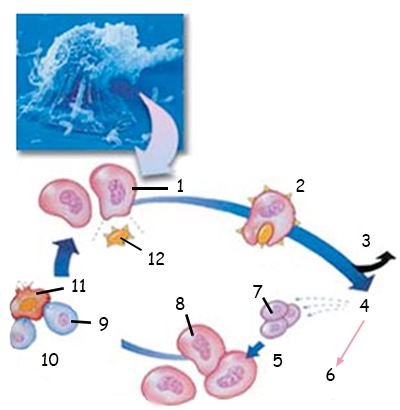 | 1) Macrophages attack the microbe. (The macrophages attack the microbe. A local inflammation is initiated.) 2) Macrophage engulfs the microbe and displays some parts on its surface. (The macrophages display parts of the microbe on their surfaces.) 3) The immune response is initiated. (This activates the specific immune response, and) 4) Proteins are secreted. (causes proteins to be secreted.) 5) Monocytes begin maturing into macrophages. (Some proteins stimulate the maturation of monocytes.) 6) Body temperature rises. (And some others cause fever.) 7) Monocytes |
Macrophages attack enemy cells they recognize by their surfaces and display parts of enemies on themselves. This signal announces the presence of an enemy in the body and initiates the immune response. | |
Everyone should stop and consider the way that a cell knows its duty and sets out to hunt down foreign particles in the body, possessing the equipment with which to do this. Phagocytes do not suddenly decide one day to start transporting oxygen or to develop into a muscle cell. As components of the defense system, they flawlessly perform the task they are charged with on a daily, even hourly basis. Their job is both very difficult and very dangerous, yet they never make a mistake when it comes to recognizing and identifying a bacterium. They seem to see, though they have no eyes, and reason and think though they have no brains. That being the case, there is clearly no relationship between their actions and any physical feature. They are under the command of God, Who has equipped every living thing on Earth with flawless features, and Who observes them at every moment.
In one verse God reveals:
It is God Who created the seven heavens and of the earth the same number, the Command descending down through all of them, so that you might know that God has power over all things and that God encompasses all things in His knowledge. (Surat at-Talaq: 12)
Since the neutrophils entering the tissues are mature cells, they can immediately initiate phagocytosis. As the neutrophil approaches the foreign cell, first it touches it, and extends pseudopods—false arms around it in various directions. Opposing arms embrace the cell, join around it and fuse together. The foreign cell is now engulfed inside the neutrophil, loses its membrane and collapses into the neutrophil's cytoplasm. A neutrophil can phagocytose and destroy 5 to 20 bacteria before it dies.
Antigen-Presenting Macrophages | ||
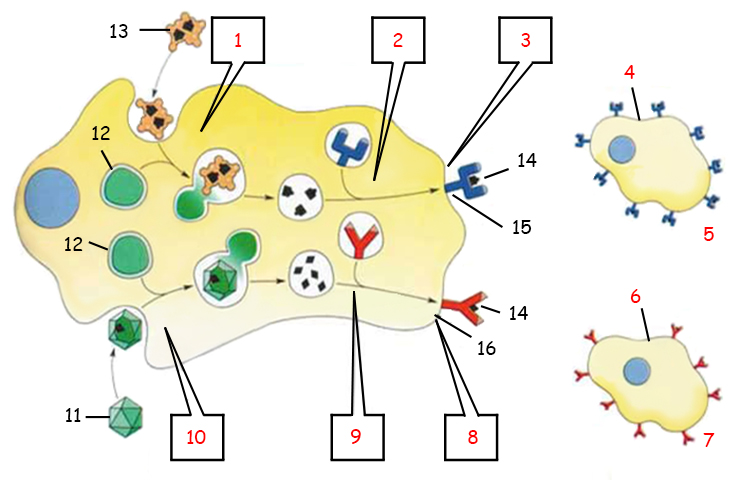 | ||
1. The macrophage captures the antigenic material, conserves and processes it. | ||
11. Viral or cancerous material | 13. Infectious material | 15. New class II antigen site |
By a most systematic method, macrophages trap and destroy a cell that has invaded the body. The macrophage captures the antigenic material and processes it to supplement one of its MHC class I or II sites. Being fixed to the MHC protein, the antigen forms a surface complex that will stimulate the T cells' surface receptors. The MHC protein within the complex determines whether it will attach to a killer T-cell or a helper T-cell. | ||
However, monocytes—the initial form of macrophages—need to mature before they can perform their tasks. Monocytes travel through the bloodstream for 10 to 20 hours before entering the tissues, whereupon they widen by swelling and become macrophages. They can live for months or even years as long as they are not broken down during the process of phagocytosis. Tissue macrophages represent a flawless system that constantly protects against infection in the tissues. Their phagocytosis methods are different from those of the neutrophils. In general, they possess the ability to phagocytose 100 bacteria. Neutrophils are unable to phagocytose cells larger than bacteria, while macrophages have the ability to eliminate much larger structures.
 |
The elements of the immune system do not just kill enemies, but also take precautionary measures in the event that specific enemy ever enters the body again. While all this is going on, most people live totally unaware of this perfect system created by God. |
Neutrophils generally digest the cells they phagocytose inside themselves. As a result of this digestion, the bacterium gives off toxic substances, and after phagocytosing 25 bacteria at most, these toxins increase to such a level as to lead to the neutrophils' own deaths. In one sense, the neutrophil sacrifices itself that the body as a whole might live. Subsequently, the dead neutrophil is itself phagocytosed and digested by the macrophages.
Macrophages, on the other hand, possess the ability to expel waste products after digesting their enemies and therefore, face no danger of being poisoned. As a result, they are still able to perform their functions for months, even for years.46
This whole account is a proof of God's omniscience, which we watch with amazement in every system we encounter. It's astonishing how minute living cells are able to identify an enemy and take the relevant precautions. Moreover, these tiny living entities also take measures to be ready in the event that these same enemies enter the body again at some later date. For that purpose, in ingesting the enemy cell, the macrophage separates off a part of it known as the antigen, which contains the enemy's identifying details. It then carries this antigen by displaying it on its own surface like a pennant, which serves as the guide for the lymphocytes, the immune system's real heroes. Thanks to this preliminary education provided by the macrophages, the lymphocytes can recognize the body's main foes. Should these same pathogens enter the body again, they are immediately destroyed by the lymphocytes.
Anyone who evaluates these facts in a rational and unbiased manner will understand how baseless is the myth that the origin of life can be a chance-based process of evolution. Of course, some continue to persist in defending the theory of evolution, despite being well aware of all these facts. Yet these people behave most dogmatically on this subject, and refuse to admit the facts of creation solely in order to reject the evident existence of God. Their rejecting all the many different and irrefutable pieces of evidence indicates that their denial has psychological roots.
Submitting to God, our Almighty Lord, and praising Him by appreciating His creations, is very difficult for such people who have glorified—in effect, deified—their own beings. What they should do, however, is simply recognize the absolute dominion of God and appreciate and give thanks to Him accordingly. The number of people who appreciate the works of God on Earth, who constantly discover new magnificent features and who have faith in God, is rising every day. A great many scientists have begun to recognize these truths and to free themselves from the myth of evolution.
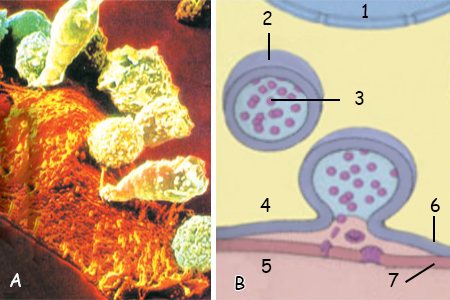 | |
(A) T-cells are attacking a cancer cell. (B) Above can be seen what the T-cells do during this process. During the attack, a Tcell releases the protein perforin inside it. Perforin opens lesions in the targeted cell membrane, letting fluid and salts enter in. As a result, the harmful cell bursts and dies. | |
1. T-cell nucleus | 5. Interior of targeted cell |
The defense provided by the macrophages is of the greatest importance to the body. Invaders are digested, primarily thanks to the activities of these intelligent cells. But since the macrophages are engaged in such intense activity, then why is there any need for lymphocytes, another group of killer cells? Why is there a need for a second line of defense?
The explanation is that invaders may have different properties. Our bodies have taken very different precautions against enemies that we might encounter at any moment. There may sometimes come the need for a wide-ranging army, because some enemies may be so powerful as to entirely take over the body they occupy. At such times of peril, the lymphocytes go into action and wage a fierce battle against the invaders.
To stop their foe's advance, lymphocytes possess poisonous chemical weapons. The way that cells just a few microns in size can initiate production of toxic substances and use it in the appropriate locations and circumstances is of course a magnificent sign of creation. Toxin production is a very complex process for even a rational human with technological means at his disposal. Yet here, the "poisoner" is just a cell traveling through the bloodstream, and it very definitely possesses no chemical knowledge. Moreover, it is not sufficient for the lymphocyte merely to manufacture that toxin. It needs to determine where it needs to be preserved and employed. Otherwise, it will be damaged by the very toxins it carries, and the body will be overcome by the attack of its very own troops.
Lymphocytes are so seemingly careful and rational that as their properties are described, you might get the impression that one is referring to a conscious entity. Yet actually such a comparison would be inadequate for the task, because even a conscious, careful human can make mistakes. That is not true of lymphocytes, however. These intelligent cells must carry the toxic substance they produce in such a way that it will harm neither them nor us.
 |
A T lymphocyte infected by the HIV virus. Despite their power, T lymphocytes are helpless before the speed at which the HIV virus constantly changes, making itself unrecognizable to the body's immune system. It attacks the immune cells and thus neutralizes this system in the body. |
As if they were aware of the danger this substance represents, lymphocytes carry it in small sacs in their cell membranes. They must know into which cells they will inject this toxin they carry with such care. Were they to lack that knowledge, this would constitute a grave threat, because these expert warriors are powerful enough to destroy every cell in the body. Any inability to distinguish between friend and foe could lead to the death of the human being.
People engaged in the field of medicine witness with complete amazement how lymphocytes recognize hostile cells, approach them and inject the poison they carry into them. How is it that a microorganism with no sensory organs can distinguish between other microorganisms that appear very little different to others? The superior abilities employed by lymphocytes during this process are truly astonishing.
Human beings recognize one another by their external appearances and voices. Lymphocytes, on the other hand, recognize enemies from the proteins they bear. Every bacterial and viral protein is different from human proteins. Immune cells can immediately detect that difference.47 In much the same way that you can tell if a stranger has entered in your home, so lymphocytes immediately recognize these unexpected guests because of their differing proteins.
Darwinists need to account for this miraculous state of affairs in terms of their own theory. The lymphocyte is a cell with no opportunity of learning through trial and error. In order for the proponents of evolution to be able to account for this, they need to explain how the defense cell in question knows how to distinguish between the body's cells and hostile ones, how it decides to kill the latter, how it produces poison to that end, and how it developed sacs to carry that poison so that it and the body as a whole should come to no harm. In addition, it also has to stay alive while doing all these things. According to the theory of evolution, all these stages must have come about by chance, because there is no consciousness or planning at the basis of evolution. Everything has to develop at random, in an uncontrolled environment.
 |
God brought you out of your mothers'wombs knowing nothing at all,and gave you hearing,sight and hearts so that perhaps you would show thanks. (Surat an-nahl: 78) |
According to evolutionist claims, the lymphocyte will have acquired its features and abilities gradually, as a result of chance mutations, and only when the body's need for defense arose. It is of course unclear how the human body might be protected during the course of imaginary random phases lasting hundreds, even thousands of years. Under these conditions, a body that had not developed a fully functioning immune system would die within a few days due to a bacterial or viral invasion. Yet whatever the suggested coincidences that might have given rise to this perfect and rational system, it developed in such an appropriate and planned manner that it underwent not a single error.
 |
It is God Who made the Earth a stable home for you and the sky a dome,and formed you, giving the you the best of forms,and provided you with good ang wholesome things.That is God, Your Lord,Blessed be God,the Lord,of all the worlds. (Surah Ghafir: 64) |
To subscribe to the above fairy tale is of course impossible. Yet this, surprisingly, is the evolutionists' fundamental claim. It is impossible for unconscious coincidences to give rise to perfect organisms, systems and complex structures without making a single mistake, because coincidences lead to errors in the system that already exists. Any random intervention in any mechanism of a particular level of complexity will inevitably harm it. Clearly, such an extraordinarily complex system as the immune system cannot have formed and developed by chance. Adorning this myth, devoid of any scientific validity, with scientific terminology is definitely not enough to redeem it.
 |
O man! What has deluded you in respect of your Noble Lord? He Who created,you and formed you and proportioned you and assembled you in whatever way He willed. Surat al-infitar: 6-8 |
In the face of this account, readers have to arrive at a decision. Either they will believe that unconscious coincidences managed all this and arranged a miracle, or else they will regard this claim as nothing more than a baseless, illogical fairy tale. Since we are referring to an immune cell with all these flawless properties, then we must clearly see that not even one unconscious, unplanned stage can enter the equation. The lymphocyte can survive and function only with all the organelles that keep it alive, the sacs capable of carrying toxic substance, and its ability to identify enemies and do battle...
It is impossible to do away with just one of these features and claim that it developed in stages over a long period of time. This cell, just like everything else, took its place in the human body, together with all its properties, at the moment chosen by God. It performs its function in the body perfectly because God so wishes. It is under our Lord's control at every moment, in everything it does.
In one verse God reveals this truth thus:
God, there is no god but Him, the Living, the Self-Sustaining. He is not subject to drowsiness or sleep. Everything in the heavens and the earth belongs to Him. Who can intercede with Him except by His permission? He knows what is before them and what is behind them but they cannot grasp any of His knowledge save what He wills. His Footstool encompasses the heavens and the earth and their preservation does not tire Him. He is the Most High, the Magnificent. (Surat al-Baqara: 255)
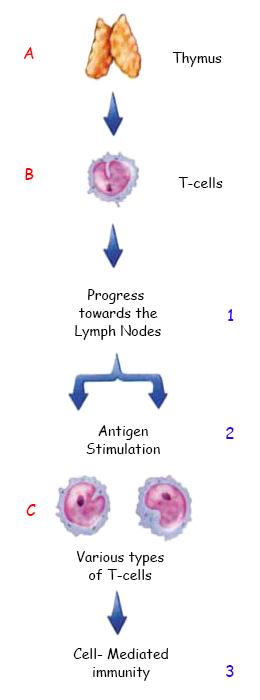 |
A. Thymus 1. Progress towards the lymph nodes T-cells, a fundamental element of the immune system, are produced in the thymus gland. Then a series of training measures begins, because the T-cells must recognize the antigens they encounter. As a result of this miraculous training, the cells are able to recognize even artificial antigens produced in the laboratory. |
B lymphocytes, the body's weapons factory, are formed in the bone marrow, travel to the lymph glands by way of the blood and continue living there. At moments of danger, the B-cells provide logistical support. The weapons they produce to kill the enemy are Y-shaped antibodies. They attach these to their cell casing until it consists of thousands of these antibodies. It is impossible for a foreign body entering the system to escape these receptor antibodies.
After assuming this mature form, B lymphocytes range through the body for years, just like a patrolman. When a stranger enters the body, a state of alarm is initiated. The B lymphocytes immediately perceive this alarm and swiftly head to the enemy's position, absorb all the proteins of the enemy they catch—a virus, for example—and break it down. They then attach fragments of the virus onto the surface of their own cells. Once matters have come to an end, the components of the virus remain on the B lymphocytes. These components are the antigens that identify the enemy to whom they belong.
After this stage, the B-cells require support. Helper T-cells, created for this purpose, immediately become aware of this need. The T-cells recognize the B-cells carrying the antigen components and approach and knock against them. During this maneuver, the B lymphocytes release a substance that contains a string of directives to the T-cells, in which it is specified that the antigen in question belongs to an enemy, and that its identity needs to be shown to other T and B-cells—in other words, to other police units.48 The helper T-cells move away as soon as they receive this directive.
At this point, it will be an advantage to gain a deeper knowledge of the T-cells, which form in the thymus gland immediately above the heart. Once they have matured, they learn to recognize various antigens. This education is most important for the rest of our lives, since an immune cell that does not recognize an antigen cannot protect the body. The T-cells that form in the thymus gland undergo such a comprehensive "education" that they can easily recognize hundreds of millions of naturally occurring antigens. What makes their learning so miraculous and extraordinary is the presence in our bodies of T-cells that can even recognize artificial antigens created in laboratories.
Evolutionists can never have any explanation for how a cell too small to be seen with the naked eye is aware of threats in the body coming from the outside and has developed means of dealing with them. The sole explanation for this magnificent fact is that the outside world and the body itself all have a single Creator. No doubt but that this Creator is God, the Creator of all.
The helper T-cells that receive this directive at moments of danger spread through the body in the light of the information they've received. By now, every B-cell in the body is aware of the enemy's presence and know all of that enemy's characteristics. In the face of this danger, the B lymphocytes, stimulated by the helper T-cells, begin to multiply, dividing literally thousands of times. Unlike the original B-cells, however, the newly produced B-cells lack the ability to perceive and destroy. Their duty is to spread through the body and seek antigens, to which they bind whenever they find them. In this way they set into operation another immune cell, the natural killers. They leave the work of destruction to these cells, which are still more powerful.
It takes around five days for the B lymphocytes to produce antibody factories and begin producing antibodies. During that time, the body's defense is turned over to immune system cells that are present from birth. During this period, a person will feel rather weak, and with generally a rise in body temperature. After five days, once the B-cells assume their duties, an immediate improvement is observed as the enemy cells are rapidly killed off.
The reason why we humans catch certain illnesses such as measles only once is that the B lymphocytes now recognize the virus at once, as soon as it enters the body, and these cells immediately digest and eliminate it. The virus has no opportunity to cause a recurrence of the disease. The reason why children are inoculated—that is, injected with killed or weakened causative agents of the disease—is to introduce the pathogen to the B-cells.49
B and T Lymphocytes Protect our Cells | |
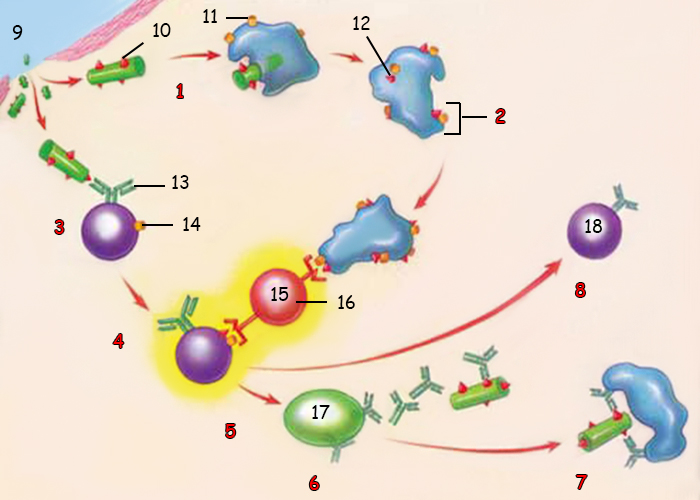 | |
1. A bacterial invasion triggers inflammatory response, including phagocytosis carried out by macrophages. 2. Enzymes inside the macrophage digest the bacterial cell, but not the antigens, which are displayed on the surface of the macrophage, combined with an MHC marker. Helper T-cells are set in motion by these antigen-MHC complexes. 3. A B-cell with the right membrane- bound antibodies also processes antigen. In this way, it, too, comes to have MHC-antigen complexes. 4. The helper T-cell recognizes the antigen-presenting macrophage. Then it interacts with the B-cell, causing it to divide. 5. Some of the newlyformed B-cells differentiate into antibodysecreting plasma cells. 6. Circulating antibodies combined with antigen mark the enemy for destruction. 7. Inflammatory response amplified (for example, more macrophages go into action). 8. Some of the newly-formed B cells differentiate into memory cells. | |
9. Bacteria enter through damaged skin | 14. MHC marker |
This diagram shows the amplification of the inflammatory response—in this example, an antibody-mediated response to a bacterial attack. Plasma cells release antibodies, which travel through the blood and mark the attackers. These marked invaders set other defense elements such as macrophages into action, enabling them to participate in the defense. | |
The Harmony Between the Antybody and Antygen | |
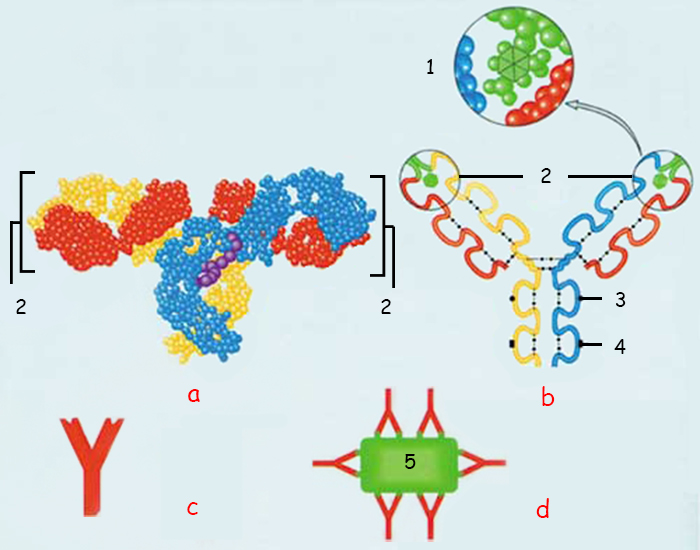 | |
a. IgG molecule model | c. Antibody symbol |
1. Detail of the antigen-antibody binding | 4. Site of binding to macrophages |
After the T-cells introduce antigens they're carrying to the B lymphocytes, the B-cells divide and begin producing the appropriate antibodies. The antibody's compatibility with the antigen is a flawless example of creation. | |
B Lympocytes Multiply and Disseminate the News of the Invasion... | |
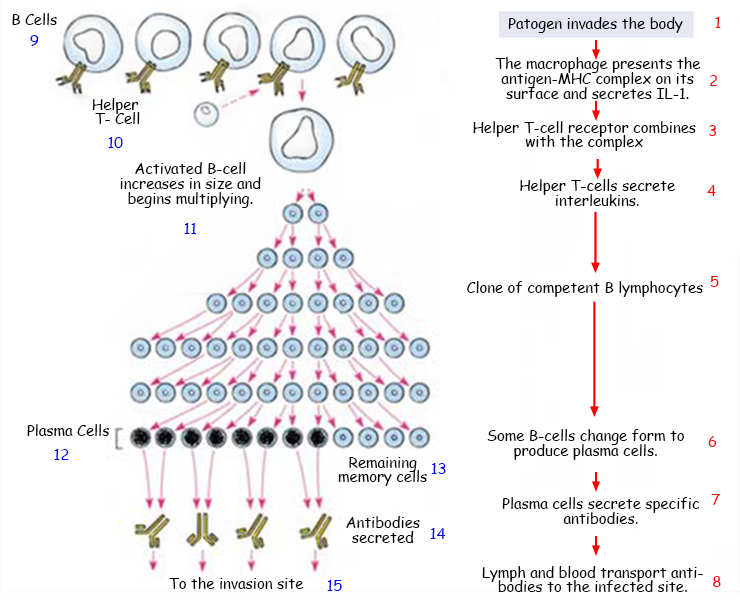 | |
1. Patogen invades the body | |
9. B cells | 13. Remaining memory cells |
When a B-cell attaches to an antigen and helper T-cells start secreting interleukin, the B-cell becomes activated. It starts multiplying and differentiate, some turning into plasma cells that secrete antibodies. The plasma cells remain in the lymph tissues, but the antibodies go to the infected sites by way of the bloodstream and lymph system. Antigen-antibody complexes form and stimulate the complement system. Some B-cells differentiate into memory cells and continue to produce antibodies, even years after the infection. | |
37 The Human Body: An Intelligent Design, pp. 113-114. 
38 "The Circulatory System," The Encyclopedia of Health, Regina Avraham, p. 50. 
39 Yusuf Alan, "Vucut, Kan" (The Body, The Blood),http://people.a2000.nl/aalan/sirlar/vuc.html, 
41 Ayten Sucu, Semra Bayar, Melahat Kupeli, Biyoloji Lise 2, ("Biology") MEB Devlet Kitaplari, Istanbul 2000, p. 26. 
42 Textbook of Medical Physiology, p. 58. 
43 Textbook of Medical Physiology, p. 58. 
44 "Eosinophil," http://www.hon.ch/Library/Theme/Allergy/Glossary/eosinophil.html 